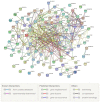Multiple Myeloma: Bioinformatic Analysis for Identification of Key Genes and Pathways
- PMID: 35958298
- PMCID: PMC9358573
- DOI: 10.1177/11779322221115545
Multiple Myeloma: Bioinformatic Analysis for Identification of Key Genes and Pathways
Abstract
Multiple myeloma (MM) is a hematological malignancy in which monoclonal plasma cells multiply in the bone marrow and monoclonal immunoglobulins are overproduced in older people. Several molecular and cytogenetic advances allow scientists to identify several genetic and chromosomal abnormalities that cause the disease. The comprehension of the pathophysiology of MM requires an understanding of the characteristics of malignant clones and the changes in the bone marrow microenvironment. This study aims to identify the central genes and to determine the key signaling pathways in MM by in silico approaches. A list of 114 differentially expressed genes (DEGs) is important in the prognosis of MM. The DEGs are collected from scientific publications and databases (https://www.ncbi.nlm.nih.gov/). These data are analyzed by Search Tool for the Retrieval of Interacting Genes/Proteins (STRING) software (https://string-db.org/) through the construction of protein-protein interaction (PPI) networks and enrichment analysis of the Gene Ontology (GO) and Kyoto Encyclopedia of Genes and Genomes (KEGG) pathways, by CytoHubba, AutoAnnotate, Bingo Apps plugins in Cytoscape software (https://cytoscape.org/) and by DAVID database (https://david.ncifcrf.gov/). The analysis of the results shows that there are 7 core genes, including TP53; MYC; CDND1; IL6; UBA52; EZH2, and MDM2. These top genes appear to play a role in the promotion and progression of MM. According to functional enrichment analysis, these genes are mainly involved in the following signaling pathways: Epstein-Barr virus infection, microRNA pathway, PI3K-Akt signaling pathway, and p53 signaling pathway. Several crucial genes, including TP53, MYC, CDND1, IL6, UBA52, EZH2, and MDM2, are significantly correlated with MM, which may exert their role in the onset and evolution of MM.
Keywords: Multiple myeloma; bioinformatics; gene expression; genetic predisposition; heterogeneity; mutational profiles.
© The Author(s) 2022.
Conflict of interest statement
Declaration of Conflicting Interests: The author(s) declared no potential conflicts of interest with respect to the research, authorship, and/or publication of this article.
Figures





Similar articles
-
Identification of key microRNAs and their targets in exosomes of pancreatic cancer using bioinformatics analysis.Medicine (Baltimore). 2018 Sep;97(39):e12632. doi: 10.1097/MD.0000000000012632. Medicine (Baltimore). 2018. PMID: 30278585 Free PMC article.
-
Identification of Key Genes and Pathways in Myeloma side population cells by Bioinformatics Analysis.Int J Med Sci. 2020 Jul 25;17(14):2063-2076. doi: 10.7150/ijms.48244. eCollection 2020. Int J Med Sci. 2020. PMID: 32922167 Free PMC article.
-
Identifying MMP14 and COL12A1 as a potential combination of prognostic biomarkers in pancreatic ductal adenocarcinoma using integrated bioinformatics analysis.PeerJ. 2020 Nov 23;8:e10419. doi: 10.7717/peerj.10419. eCollection 2020. PeerJ. 2020. PMID: 33282565 Free PMC article.
-
Bioinformatics Analysis of Candidate Genes and Pathways Related to Hepatocellular Carcinoma in China: A Study Based on Public Databases.Pathol Oncol Res. 2021 Mar 26;27:588532. doi: 10.3389/pore.2021.588532. eCollection 2021. Pathol Oncol Res. 2021. PMID: 34257537 Free PMC article.
-
Integrative bioinformatics approaches for identifying potential biomarkers and pathways involved in non-obstructive azoospermia.Transl Androl Urol. 2021 Jan;10(1):243-257. doi: 10.21037/tau-20-1029. Transl Androl Urol. 2021. PMID: 33532314 Free PMC article.
Cited by
-
The TT Genotype of the KIAA1524 rs2278911 Polymorphism Is Associated with Poor Prognosis in Multiple Myeloma.Cells. 2023 Mar 28;12(7):1029. doi: 10.3390/cells12071029. Cells. 2023. PMID: 37048102 Free PMC article.
-
The mechanism of LSM2 in the progression of live hepatocellular carcinoma was analyzed based on bioinformatics.Med Oncol. 2023 Aug 23;40(9):276. doi: 10.1007/s12032-023-02152-0. Med Oncol. 2023. PMID: 37612479
References
LinkOut - more resources
Full Text Sources
Research Materials
Miscellaneous

